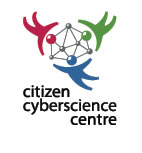(This is a report from the Citizen Cyberscience Summit which we have written about in a previous blog posts.)
On September 2-3, some 50 people gathered in the Anatomy Theatre in King’s College, London for two intense day filled with presentations and discussions about Citizen Cyberscience. The programme featured thirty presentations, one panel, and one brainstorming session as well as generous breaks where we could not only enjoy coffee, lunch, and a pre-evening session aperitif but also get welcome opportunity to talk to speakers and listeners.
Distributed computing
Many of the presentations related to projects where the citizen involvement consisted of giving up (unused) computer processing power, sometimes called ‘volunteer computing’. Even though many of these projects have the same kind of basic set-up and may also be using the same application, the presentations showed that volunteer computing can be used in many contexts. Myles Allen (Head of ClimatePrediction.net, Univ. of Oxford) discussed the important role volunteer computing can fill in his talk Why does climate science need exaflops? Nicolas Maire (Swiss Tropical Institute and MalariaControl.net) showed How volunteer computing is supporting malaria control efforts in Africa and Elizabeth Cochran (Quake-Catcher Network) told us about Distributed Sensing: using volunteer computing to monitor earhtquakes around the world, to mention but a few examples. Many, but not all, projects are using the BOINC platform.
The intent of BOINC is to make it possible for researchers to tap into the enormous processing power of personal computers around the world. (Wikipedia)
If you want to see what other distributed computing projects there are, check out the BOINC website and the list in Wikipedia.
Distributed thinking
Other presentations focussed on projects more similar to the ones we usually see in relation to RunCoCo – projects where participants donate their own time and effort by completing tasks where actual human input is needed. Tom Humphrey (Botanical Society of the British Isles) spoke about Herbaria@home where volunteers help document herbarium sheets. Steven Bamford (Univ. of Nottingham & Citizen Science Alliance) showed how the successful Galaxy Zoo project has evolved and carried on to other Galaxy Zoo projects, now collected under the Zooniverse umbrella. Not all the Zooniverse projects are related to astronomy, as Philip Brohan (UK Met Office) showed. He talked about Old Weather, a project aiming to collect historical climate records from naval log books. An interface is expected to be released to the general public at the end of September 2010, so we will no doubt hear more about this exciting initiative (funded by JISC within their Developing Community Content strand) .
Other topics
There were also an interesting set of more generic presentations, such as David Grier’s talk Lessons from the Ancient History of Crowd Sourcing where he talked about ‘human computers’. He described how the Mathematical Tables Project mass-produced calculations using unskilled labour – a kind of distributed computing effort which started in 1938. Matt Blumberg (GridRepublic) talked about ‘computing and thinking’ and got us all thinking by offering some fascinating numbers based on the football World Cup. Allegedly, some 700 million people watched the final. If they all spent 90 minutes on that task, that would correspond to nearly 120,000 years! Imagine what could be done with that kind of human input into a project. Even if we don’t expect our projects to attract the kind of world-wide attention and interest that a World Cup final evokes, the calculation shows that if you have a large enough number of volunteers, they do not each have to offer much time for the total effort to be considerable.
In addition to the presentations, the Summit also features two sessions with more audience participation. In the panel discussion The Anatomy of Citizen Cyberscience a number of cyberscientists participated and told us about their involvement in citizen cyberscience. The Summit closed on the Friday with a brainstorming session about the future of the field. Nine questions were raised and the participants then took turns to offer one answer to one of these. The result will be used to try to come up with a Manifesto for Citizen Cyberscience. The questions, as well as the suggested answers, can be found via Twitter. The tweets from the Summit have been archived in the CCC blog. They, and any later contributions, can also be found by searching Twitter for the tag #cybersci.
More information
If you want a presentation of the talks and the speakers, follow the links here below:
- The programme for the event, with a list of all the speakers and their talks
- Summaries and some video recordings and interviews are available in the Citizen Cyberscience Centre and GridCast blogs
- Notes/transcripts from many of the presentations were written on the day by Suw Charman-Anderson who is making them available on her blog for Thursday 2 Sept and Friday 3 Sept
- Alastair Dunning asks an important question – do cyberscientists need to think more about the communities they work with?
- The Summit even featured in an article in the New Zealand Herald

[…] recordings of the talks, interviews, presentation slides and much more, see our earlier blog post ‘Post-summit thoughts‘ and the Citizen Cyberscience Centre blog. Posted in events (external) | Leave a […]